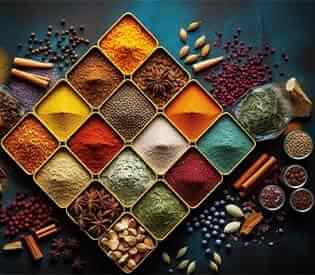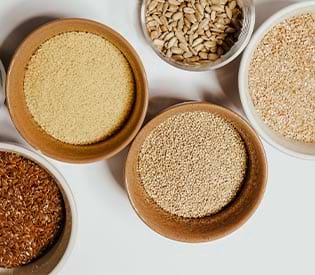Guarana Seed
📦🚚 Fast & Free shipping on all orders
What is guarana seed?
Paullinia cupana, an indigenous species of the Amazon basin, is characterized by its climbing habit, expansive foliage, and the presence of white flower clusters. Guarana is mostly recognized for the seeds of its fruit, which are rich in caffeine and have gained significant popularity as a constituent in energy beverages. The plant has a rich historical background in its use by the Satere-Mawe tribe, who were the original cultivators of this botanical species. The common use of guarana seed involves its preparation as an invigorating tea, extraction, or incorporation into culinary practices.
Guarana, a perennial evergreen plant, is a spreading vine with shrub-like characteristics that is indigenous to the Amazon area. The guarana tree is known for its production of red berries, which have been used as a coffee substitute in its indigenous region of Brazil for an extensive period of time. Upon reaching maturity, the berries undergo a process of splitting apart at their terminal end, resulting in a visual resemblance to the anatomical structure of a human eyeball. According to a tradition originating from the Satare-Mawe indigenous community in Brazil, it is recounted that a lady of remarkable beauty called Onhiamuacabe had a kid whose paternity was attributed to an enigmatic entity. The youngster faced execution for consuming a variety of prohibited nuts. A guarana shrub sprang from his eye socket at the location of his interment. The indigenous population of India continues to attribute supernatural qualities to the effects of guarana.
The guarana seeds undergo a process of drying and roasting. The beverage is prepared by a process of brewing, resulting in an initial taste characterized by bitterness and a mild astringency, which then transitions into a sweet flavor profile. Previous literary works make mention of a drug known as guaranine, purportedly possessing comparable chemical properties to caffeine. In contemporary discourse, several scientists contend that the compound in question has the attributes of caffeine, therefore establishing guarana as the most abundant natural reservoir of caffeine. The caffeine content in guarana seeds is 2.5 times higher than that found in coffee.
The cultivation of guarana may be traced back to pre-Columbian times, when it was used by indigenous populations. Its commercialization, however, did not occur until 1958. The potential health advantages of guarana have been the subject of much study; however, more investigation is still required. The botanical classification of the plant indicates its membership in the Sapindaceae plant family.
How do you use guarana seeds?
Three times daily, one cup of guaraná may be ingested, which is made by combining 1/4–1/2 teaspoon (1–2 grams) of pulverized seed or resin with one cup (250 ml) of water and bringing to a simmer for ten minutes. There may be as much as 50 mg of caffeine per cup.
Guarana Seed Benefits:
Guarana has physiological effects similar to those of coffee on the cardiovascular system, vasculature, and central nervous system. Guarana has historically been used in traditional medicine for its stimulant properties, as well as its moderate diuretic effects. Additionally, it has been utilized as a tonic to enhance alertness, suppress appetite and thirst, and alleviate symptoms associated with headaches, dysmenorrhea, and digestive ailments.
◉ Rich in Antioxidants: Guarana has a plethora of chemicals that have antioxidant effects. The aforementioned compounds include caffeine, theobromine, tannins, saponins, and catechins. Indeed, guarana has an antioxidant composition that closely resembles that of green tea. The significance of antioxidants lies in their ability to counteract the adverse effects of free radicals, which are molecular entities that possess the capacity to cause damage. These molecules can engage in interactions with cellular components, hence inducing detrimental effects associated with the processes of aging, cardiovascular disorders, malignancies, and several other pathological conditions. In vitro experiments have indicated that guarana has antioxidant qualities that might potentially impede the proliferation of cancer cells, mitigate the risk of cardiovascular disease, and alleviate the effects of skin aging.
◉ Can Reduce Fatigue and Improve Focus: Guarana is mostly recognized for its use as a constituent in widely consumed energy beverages. This particular substance serves as a very effective stimulant, facilitating the sustenance of concentration and cognitive vitality. Indeed, studies have shown that guarana seeds contain four to six times more caffeine than coffee beans. The mechanism of action of caffeine involves the inhibition of adenosine, a neuromodulator that promotes relaxation inside the brain. The compound has an affinity for adenosine receptors; hence, it impedes their activation.
According to a research study, those who consumed a vitamin supplement containing guarana reported experiencing reduced fatigue levels after completing several tasks, in contrast to those who were administered a placebo. Notably, research findings indicate that guarana has the capacity to mitigate cognitive exhaustion resulting from cancer therapy while exhibiting few adverse reactions.
◉ May Help You Learn Better: Numerous studies have indicated that guarana has the potential to enhance cognitive functions related to learning and memory. Research was conducted to examine the impact of varying dosages of guarana on mood and cognitive performance. The participants were administered several doses of guarana, including a placebo group and groups receiving doses of 37.5 mg, 75 mg, 150 mg, or 300 mg.
The individuals who received either 37.5 mg or 75 mg of guarana exhibited the highest levels of test performance. The partial responsibility for the effects of modest dosages of guarana, beyond caffeine, is attributed to other chemicals present in guarana. A separate study conducted a comparative analysis of guarana and ginseng, both of which are compounds known for their cognitive-enhancing properties. While both guarana and ginseng showed positive effects on memory and test performance, those who were administered guarana exhibited higher levels of task engagement and quicker task completion. Moreover, previous research conducted on animals has shown that guarana has the potential to enhance memory function.
◉ May Promote Weight Loss: A reliable source estimates that approximately one-third of individuals in the United States fall into the obesity category. The issue of obesity is becoming worrisome due to its association with several chronic ailments, such as cardiovascular disease, type 2 diabetes, and cancer. It is worth noting that guarana has potential qualities that may contribute to the facilitation of weight reduction. Initially, it is noteworthy that guarana has a substantial quantity of caffeine, thereby potentially eliciting a metabolic enhancement of 3–11% over a span of 12 hours. A heightened metabolic rate results in an increased caloric expenditure during periods of bodily rest.
Moreover, scientific investigations conducted in test tubes have shown that guarana has the potential to inhibit genes associated with the development of fat cells, while simultaneously activating genes that impede this process. Nevertheless, the impact of guarana on adipocyte generation in humans remains uncertain.
Where to buy guarana seed?
Buy guarana seed from the health food store in the USA, Alive Herbals.
Guarana Seed Information (at a Glance):
| Product Name | Guarana Seed. |
| Scientific Name | Paullinia cupana. |
| Country of Origin | It is native to Brazil. |
| Ingredient | Guarana Seed. |
| Taste and Aroma | Aroma: fruity scent. Taste: Bitter. |
| Shelf Life and Storage | Shelf life is about 6–24 months. Store it in an airtight container in a cool, dry place and prevent sunlight exposure. |
| Precautions | We requested that, before consuming spices, herbs, teas or any kind of natural product, you consult an expertly qualified healthcare practitioner or herbalist. |
| Note | This product information has not been appraised by the Food and Drug Administration (FDA). This information is solely intended for educational purposes. |







